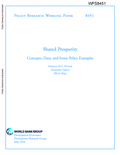Shared prosperity: concepts, data, and some policy examples
Ferreira, Francisco H. G. / Emanuela Galasso / Mario NegreExternal Publications (2018)
Washington, D.C.: World Bank Group (Policy Research Working Paper 8451)
This title has also been published as
IZA Discussion Papers 11571 (Institute of Labor Economics, Bonn)
"Shared prosperity" has become a common phrase in the development policy discourse. This short paper provides its most widely used operational definition -- the growth rate in the average income of the poorest 40 percent of a country's population -- and describes its origins. The paper discusses how this notion relates to well-established concepts and social indicators, including social welfare, poverty, inequality, and mobility, and reviews some of its design shortcomings. The paper then looks at household survey data to assess recent progress in this indicator globally. The analysis finds that during 2008–13, mean incomes for the poorest 40 percent rose in 60 of 83 countries. In 49 of them, accounting for 65 percent of the sampled population, it rose faster than overall average incomes. Finally, the paper briefly reviews a (non-exhaustive) range of 'pre-distribution' and 'redistribution' policies with a sound empirical track record of raising productivity and well-being among the poor, thus contributing to shared prosperity.


